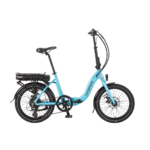I'm not sure about the 11 tooth motor sprocket reducing the assist ratio.
P(power) w(angular velocity) T(torque)
P=wT
At a fixed reference road speed, with an 11 tooth sprocket, w will be less than with a 9 tooth, but as a cosequence, won't T increase, thus compensating?
ie w9>w11 and T9<T11
Had a rethink about this and it is complicated. P varies with w, so T will not increase by w11/w9. Need to give this some more thought to what it will do. There is nothing linear here!
I think my original statement was wrong though - far too simplistic. In fact my current thinking is that the assist will be much more adversely affected by changing a 9T to a 11T.
The way I originally thought about this is that for a given power output by the motor, the amount put in by the rider will have to rise when the sprocket size is increased, because the rider will have to pedal faster to maintain the same motor power. I assumed that the rider will have to put in a factor of 11/9 more power, but I think this is now wrong.
For example, assume the rider is putting in 100W and the motor is delivering 100W with the 9T in place, for an assist of 1:1. Now swap the 9T for an 11T. To get the same 100W from the motor, the rider now pedals faster to keep the motor rpm the same as it was before. The rider must increase cadence by a factor of 11/9. Assuming the resisting force does not change (it will of course because wind resistance goes up with square of velocity), that means that the spped of the bike will now be go up by 11/9 hence total power of bike + rider must now be 11/9 of the previous amount. That means the power is now 200*11/9W, or about 244W. Now 100W of this is supplied by the motor (unchanged since w is the same) and 144W provided by the rider. That means the the assist ratio is 100:144 (More accurately 1:13/9).
I have assumed that the motor power does not change. Actually the power output by the motor may be higher because the rider is increasing torque and the power of the motor increases due to the torque sensor! This does however have an upper limit.







